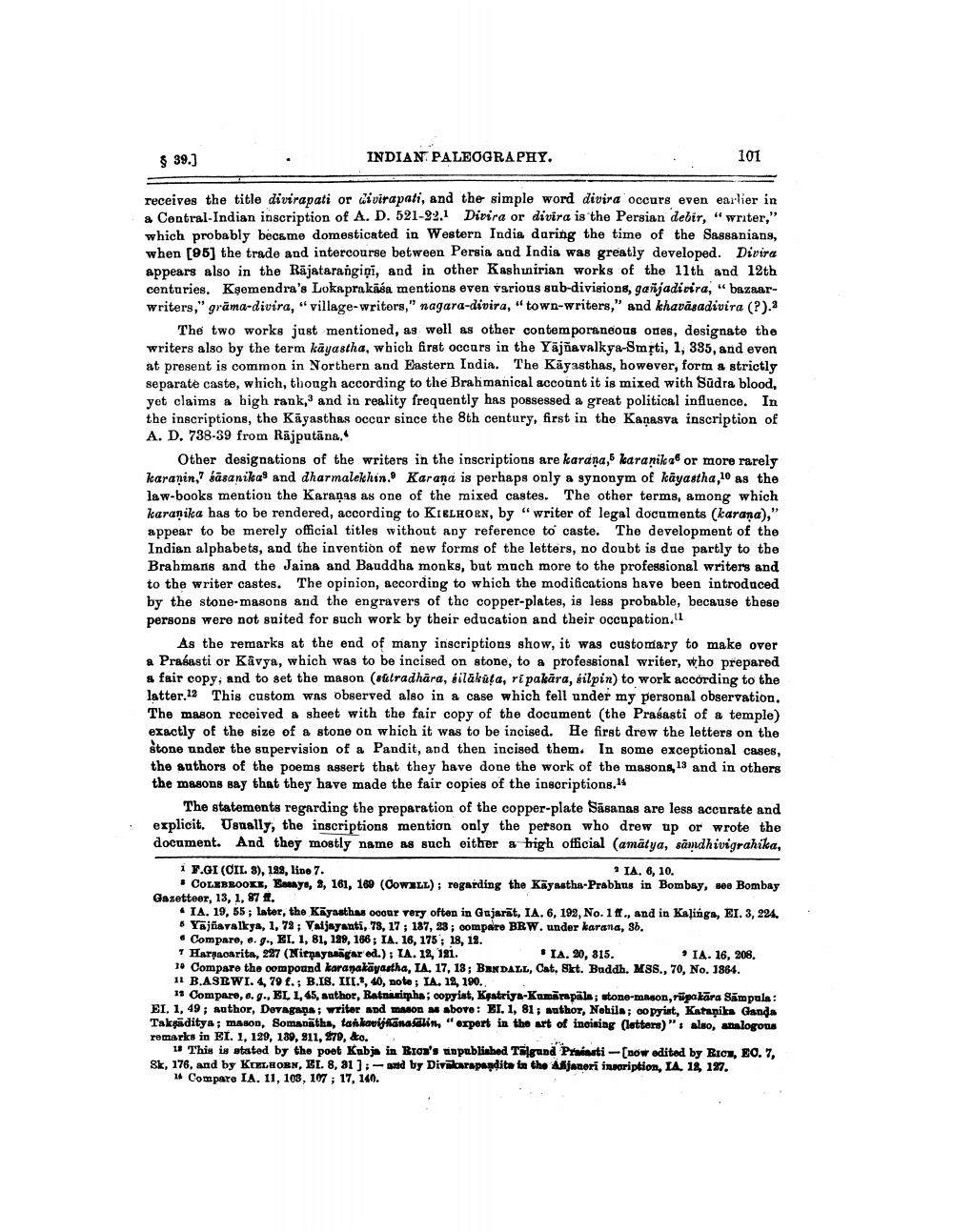________________
§ 39.]
INDIAN PALEOGRAPHY.
101
receives the title divirapati or divirapati, and the simple word divira occurs even earlier in a Central Indian inscription of A. D. 521-32.1 Divira or divira is the Persian debir, “writer," which probably became domesticated in Western India during the time of the Sassanians, when [95] the trade and intercourse between Persia and India was greatly developed. Divira appears also in the Rājatarangiņi, and in other Kashmirian works of the 11th and 12th centuries. Kşemendra's Lokaprakāśa mentions even various sub-divisions, gañjadi vira, "bazaarwriters," grāma-divira, "village-writers," nagara-divira, "town-writers," and khaväsadivira (?).
The two works just mentioned, as well as other contemporaneous ones, designate the writers also by the term kāyastha, which first occars in the Yājñavalkya-Smști, 1, 385, and even at present is common in Northern and Eastern India. The Kayasthas, however, form a strictly separate caste, which, though according to the Brahmanical account it is mixed with Sūdra blood, yet claims a bigh rank, and in reality frequently has possessed a great political influence. In the inscriptions, the Kāyasthas occur since the 8th century, first in the Kaņasva inscription of A. D. 738-39 from Rājputāna.
Other designations of the writers in the inscriptions are karana, karanika or more rarely karanin,? sasanikas and dharmalekhin. Karana is perhaps only a synonym of kāyastha,10 as the law-books mention the Karanas as one of the mixed castes. The other terms, among which karanika has to be rendered, according to KIELHORN, by "writer of legal documents (karana)," appear to be merely official titles without any reference to caste. The development of the Indian alphabets, and the invention of new forms of the letters, no doubt is dae partly to the Brahmans and the Jaina and Bauddha monks, but much more to the professional writers and to the writer castes. The opinion, according to which the modifications have been introduced by the stone-masons and the engravers of the copper-plates, is less probable, because these persons were not suited for such work by their education and their occupation.
As the remarks at the end of many inscriptions show, it was customary to make over a Prasasti or Kavya, which was to be incised on stone, to a professional writer, who prepared & fair copy, and to set the mason (sutradhāra, silakūta, ri pakāra, kilpin) to work according to the latter.12 This custom was observed also in a case which fell under my personal observation. The mason received a sheet with the fair copy of the document (the Prasasti of a temple) exactly of the size of a stone on which it was to be incised. He first drew the letters on the stone under the supervision of a Pandit, and then incised them. In some exceptional cases, the authors of the poems assert that they have done the work of the masons, 13 and in others the masons say that they have made the fair copies of the inscriptions.14
The statements regarding the preparation of the copper-plate Sāsanas are less accurate and explicit. Usually, the inscriptions mention only the person who drew up or wrote the document. And they mostly name as such either a high official (amatya, samdhivigrahika,
1 F.GI (CIL. 3), 122, line 7.
IA. 6, 10. • COLEBROOKE, Easnyo, 8, 161, 160 (COWBLL); regarding the Käyaatha-Prabhus in Bombay, see Bombay Gazetteer, 13, 1, 87 A.
* IA. 19, 55; later, the Kiyaathas ocour very often in Gejarāt, IA. 6, 192, No. 181., and in Kalinga, EI. 3, 224. 6 Ysjavalkya, 1, 72; Vaijayanti, 78, 17; 187, 23; compare BRW. under karana, 86. • Compare, e. 9., EI, 1, 81, 129, 188; IA. 16, 175; 18, 19. Harracarita, 227 (Nirnayasagar ed.): IA. 18, 191.
.IA. 20, 815.
IA. 16, 208. 10 Compare the oompound karanakayastha, IA. 17, 18; BANDALL, Cat, Skt. Buddh. MSS., 70, No. 1864. 11 B.ASEWI. 4,79 €.; B.I8. III., 40, noto; IA, 12, 190. .
13 Compare, a. 9., EL, 1, 45, author, Ratnasimha; copyist, Katriya-Kumrapala; stone-mason, riipakāra sāmpuls: EI, 1, 49; author, Davagans; writer and mason m above: EI. 1, 81; author, Nebils; copyint, Katapiks Ganda Takgaditya; mason, Somanatha, tankavlanasalin, "expert in the art of inoining (letters)": also, analogous remarks in El. 1, 129, 189, 911, 79, &o.
15 This is stated by the poet Kubja in Bio's unpublished Tolgund Praiati (now edited by Rics, EO. 7, Sk, 176, and by KIELEORN, EL. 8, 81 ): -and by Divakarapandita on the Aljaneri insoription, IA. 12, 137.
14 Compare IA, 11, 103, 107; 17, 140.




